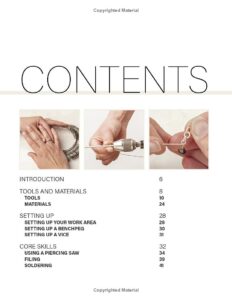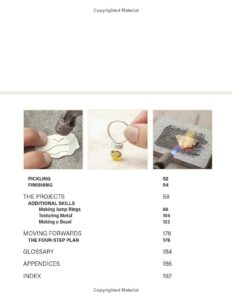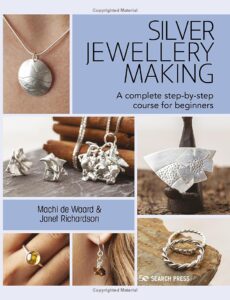Episode 207
What you’ll learn in this episode:
- Why even jewelry novices can learn to make silver jewelry at home with affordable tools
- How Machi and her co-author Janet turned their in-person jewelry making classes into a book
- What safety concerns to consider when making DIY jewelry
- How working with silver compares to working with other metals, and where beginner makers should start
- What mistakes beginner makers commonly make and how to fix them
About Machi de Waard
Machi de Waard is a designer-jeweller and jewellery tutor. Jewellery has been her full-time pursuit since early 2007, and Machi’s work has been shown at galleries, fairs and exhibitions. Machi combines her studio practice with teaching, having taught jewellery making for over ten years in various locations throughout the UK. Her interests in modern art, particularly in sculpture and minimalism, influence her work.
Additional Resources:
www.machidewaard.co.uk
insta: @machi_jewellery
www.janetrichardson.co.uk
insta: @janrichardsonjewellery
Book links:
- Amazon UK
- Waterstones
- Blackwells
- Search Press
- Guardian Bookstore
- Amazon USA
- Penguin Random House
- Bol.com in the Netherlands
- Amazon Germany
Photos (by Mark Davison at Search Press Studios)



Janet Richardson

Transcript:
Working with metal might seem like something best left to the pros, but Machi de Waard’s new book smashes that misconception. Written with Machi’s friend and co-author Janet Richardson, “Silver Jewelry Making: A Complete Step-By-Step Course,” includes seven projects that help beginner makers build on their skills and make real jewelry at home with simple tools. Machi joined the Jewelry Journey Podcast to talk about the serendipitous way the book got published; why silver is the best metal for beginners to start with; and which common mistakes DIY makers should watch out for. Read the episode transcript here.
Sharon: Hello, everyone. Welcome to the Jewelry Journey Podcast. This is the first part of a two-part episode. Please make sure you subscribe so you can hear part two as soon as it’s released later this week.
Today, my guest is Machi de Waard. She, along with Janet Richardson, is the coauthor of the book “Silver Jewelry Making.” They are both jewelers and teachers in Great Britain, and that’s where she’s speaking to me from. “Silver jewelry making” is a step-by-step course teaching you how to make silver. The book is published by Search Press.
Perhaps you don’t have time to go to class to learn these things, or perhaps you’re already in a class, but you want to have something you can turn to for troubleshooting. This could be the book. The emphasis is on good teaching, good practice and familiarizing readers with the tools they need and the purpose of each tool. The book has seven projects, each one building on the other. In addition, there is a glossary, conversion tables and other ideas on how to take each project further or what else you can do with it. Safety is also emphasized.
Machi is going to be the spokesperson, but she’ll be talking with Janet in mind also. Machi, welcome to the program. We’re all looking forward to hearing from you about this book.
Machi: Thank you very much for having me.
Sharon: We’re very glad to have you. Tell us, how did you decide to write the book on silver jewelry making?
Machi: We really wanted to write a book. I’m not using the royal we here. It was always going to be me and Janet. We really wanted to write a book that was like being in class with us. Not a book that left you in the lurch when you’re getting stuck on something, but a book you can constantly refer to and that will help you out of tricky situations. As you said, it’s a step-by-step guide. It guides you through from the very beginning to building on your skills and how to build those skills, to the point where you can design your own jewelry, with a lot of tips and tricks and troubleshooting help along the way.
Sharon: Is this designed for somebody doing it on their own or in a class?
Machi: It could be either. It depends on your learning style. It’s absolutely possible to just sit down with the book and read it and do it yourself at home, but if you want to use it in conjunction with a class, it would work like that as well. If you’re working in the class, you can go home and do a bit and read it if you get stuck. Even if you prefer to be in a class, you could do the class but then read the book. It would help consolidate your knowledge and build your skills you’re learning in your class.
Sharon: Do you think somebody can learn how to make silver jewelry on their own?
Machi: Yes, absolutely. Luckily, jewelry doesn’t actually take up that much room. It’s totally possible to do it at your kitchen table or if you have some room in a garage or a shed. You can absolutely do it at home with a book. And there are so many things on the internet. On the one hand, it’s great, but on the other hand, the quality control is not necessarily always there. So, having this book that has things with safety, as you mentioned, and all the details on how to overcome problems that might arise, that’s why you can do it totally on your own if you want to.
Sharon: Why did you think it was necessary? If I can go on Google anytime and find out this information, why was it necessary to write a book?
Machi: I think there are two things. One is, unfortunately, a lot of stuff on the internet is maybe not—I’m not going to say incorrect, but not the best advice. Sometimes it can be a bit confusing. So, it’s having all the information in one place, and because Janet and I both have so much experience teaching, we know everything in here works. Also, sometimes when you’re reading things or you see stuff on the internet, it’s like, “You must do it this way.” But jewelry making has been around for several millennia, so everything could pretty much be done two or three or even more different ways. We try to emphasize that you could do it this way or you could do it this way, and the important thing is finding the one that works for you.
Sharon: You mentioned that you have a lot of experience teaching. You both have won awards for your jewelry, is that correct?
Machi: Janet has—I just finished an MA at the Royal College of Art in jewelry and metal. I finished two weeks ago. My work was chosen as one of the best of the graduate work this year in the country, which was fantastic. Janet’s jewelry has actually been in Vogue Magazine and is part of the collection of the Dallas Museum of Art, I believe.
Sharon: I think it’s Houston or one of them in the state. Why did you decide to write the book on silver if you have all this experience in different areas?
Machi: Both of us mainly work in silver, so that’s our main metal. We know how to work it really well and we have a lot of experience in it, teaching it as well. I can’t remember if I said this already, but Janet has been teaching for over 45 years. I’ve been teaching for over 15. So, we know what happens in the classroom and when people have problems working with silver. We have a lot of advice.
Sharon: Is silver easier to work than other metals?
Machi: No, it’s just different. Every metal has its properties and its own ways of being easier or harder. I would say it’s just different. For example, if you know how to work with silver, it’s quite easy to then move on to gold, although you will have to adjust certain things. We work a lot with copper and brass as well because those are similar in their working properties, but much cheaper. You can practice things in copper if you wanted to before making it in silver. Each metal has its own pros and cons, and you just have experience with it. The more experience you have, the more different metals you can work with.
Sharon: Why did the two of you decide you had to write a book? Why was it the two of you as opposed to writing on your own or Janet on her own?
Machi: We’ve known each other a long time now, so we already knew we could work together. Actually, we’re good friends, but we also cover each other’s classes. Sometimes I can’t teach, so she does mine and vice versa. A few years ago—it must have been quite a while ago now—I realized that she had really refined her teaching strategy. She had a really good, 10-week program that had projects that build and build the core skills. At the end of the 10 weeks, the student could move on to their own designs. I thought, “This whole structure is so beautifully done. It works so well. It would be ideal for a book.” So, it was my idea to write a book, but it’s her experience and her class structure that we used.
Sharon: Did you have to think about it a while before you actually wrote the book? Did the two of you have to think about it?
Machi: No, we already knew exactly what we wanted to do because our teaching style is very similar. We knew the projects we wanted to include. We knew basically exactly what we wanted to do. So, that was a good thing.
Sharon: Can somebody spend $10 or $20 or $50? How much do they have to spend in order to have the stuff to start making something?
Machi: The way we structured the book, it’s sequential. You should start at the first project and then build on that. Each project has a list of tools you need for that project, and then the next one says what more tools you need. A lot of the tools are things you have at home already, like a glass bowl and a marker pen and a piece of paper, that kind of thing.
Then there are a few specialized tools you need to get. At the beginning of the book, we have a large section about all the tools and which ones are worth investing in a higher-quality version, which ones aren’t, which ones can be substituted with a regular household item like a teaspoon. It really depends on how much money you want to spend because many of these tools—there’s a huge trade in secondhand tools. If you have time, you can shop around and get a good deal.
To answer this question, this morning I had a look at the first project. If you buy everything new, if you don’t already have some of the household things like a glass bowl, it’s roughly 120 pounds, which is $150, to get all the tools new. That means you could definitely spend less than that. For example, if you’ve done beading before, you will already have pliers. It’s kind of a woolly answer, but it depends on what you already have; it depends on how much time you want to shop around; it depends on whether you go to car boot sales, which are not called that in the U.S. What are they called? Garage sales. If you to garage sales, that’s it.
Sharon: I’ve done only a little bit of silversmithing, but the big thing I remember is the safety and the gases and all of that. How do you deal with that?
Machi: Silversmithing is bigger, so there are more issues, but jewelry making is quite small. Generally, the safety is about protecting your eyes and your hands and feet, so goggles, gloves and closed shoes. Then there’s really commonsense stuff, like if you have long hair, you should tie it back. You shouldn’t wear dangly scarves or anything that could get caught in the machinery. When you’re working that small, there are some precautions, but you don’t need any of the fancy equipment. The main thing I would say is you need to have some sort of ventilation. You can’t work in a completely closed room with no windows.
Sharon: Why did you decide that you had to write a book like this? What was the catalyst?
Machi: I have a huge collection of jewelry books. It’s sort of embarrassing how many I have. I have pretty much all of the ones that have been written. But sometimes the problem is that they would explain a certain skill that I was interested in, and then I sat down to do it and there wasn’t quite enough detail to do it. I would sit there and be like—it would say something like, “And now solder,” and I was like, “But how?” and “What do you mean?” and “Which solder?” and “What are the details?” We tried to breach that being extremely detailed and acting like we were there in the room with you saying, “Don’t forget to do this. If it doesn’t work, try this,” all those little details that make it possible to do it successfully.
Sharon: Can you wear this stuff afterwards?
Machi: Oh yes, absolutely.
Sharon: So, you make earrings or a necklace, something you can wear.
Machi: Yes.
Sharon: What do you do with the things you’ve made? Do you exhibit them?
Machi: My own work you mean?
Sharon: And Janet’s.
Machi: Oh yes, both of us sell. We have work in galleries and craft fairs and exhibitions and a little bit online as well, but mostly we do in-person craft fairs and shows and things where we sell our jewelry.
Sharon: What made you decide you wanted to get a master’s in—I don’t know what you call it there, but here we call it a master’s—in the different kinds of metals?
Machi: Yeah, it is a master’s. The Royal College of Art here has an incredible amount of equipment, so it was partially to try new equipment that I wouldn’t have any access to normally. Also, their technicians there are phenomenally skilled. It was all the little things that are like, “Yeah, I could do that a bit better.” It was a year to really push my skills to the next level. It was an enormous challenge to spend that much time making something absolutely perfect.
Sharon: What did you learn that you didn’t know before?
Machi: I generally make jewelry, so I made some larger pieces. I did something called scoring, which is like origami except with metal. You make a tool which you score the metal with. If you can score paper, you just fold it, but you can’t fold metal. You have to make a little groove to fold it. So, I made the tool to make those little grooves, and those little grooves are at exact angles depending on how far you want to bend it up. If you do 45 degrees, then you can bend it so you can get different angles on a larger piece. Essentially it was miniature silversmithing. So, that was interesting.
Sharon: Was that your choice?
Machi: Yes, that was my choice. The other thing I did was learn how to use a hydraulic press and make steel dies to press forms, which was a totally different thing for me. That was really fascinating, to learn how to make tools myself.
Sharon: I would have been afraid of smashing my fingers or something.
Machi: Funny you should say that. I did smash my finger and I ended up in the hospital, but luckily it wasn’t too bad. I did not do any lasting damage, but yes, it’s definitely possible to hurt your hands. I wouldn’t recommend it because it really was not good. I had my finger in a bandage for three weeks. I could have never finished this degree without Janet because she had to be my right hand for a couple of weeks. So, I feel like we both earned this.
Sharon: Did you tell her what to do step by step or did she know what to do?
Machi: She’s very experienced, and she helped me with the hydraulic press because I couldn’t pull the lever anymore because I had this huge bandage on. So, she was helping me, and she had to saw for me. She knew what to do, but it was definitely a team effort.
Sharon: Did you learn something about safety in doing that?
Machi: Yes, because I hadn’t worked that much with steel. When you put steel on a lathe, which is what I was doing, the edges can become ludicrously sharp, like sharper than the sharpest knife. I didn’t realize that, and now I will never forget it.
Sharon: So, steel is harder to work with than if you’re working with silver.
Machi: Yes.
Sharon: You can cut yourself. Can you do this on your own at home? You say you have a kitchen table or—
Machi: Not working on steel, no. Silver is much softer. You’re not going to hurt yourself like that; I mean, thankfully not. I was working with some really big equipment at the college, which you normally would never have any access to. Just working with silver, what we’re doing in the book with jewelry, it would take some doing to hurt yourself. We’ve highlighted all the safety issues at the beginning of the book and also per project. So, you should be totally safe.
Sharon: Aren’t there any issues with fumes or anything like that?
Machi: Not for the projects we have in the book. I’m trying to think if there’s anything. No, nothing specific that we have in the book. We use Platinol, which is an oxidizing solution which is not dangerous, but it smells terrible. We advise ventilation because it smells like rotting eggs, but if you smell it, it’s not going to be dangerous for you in any way. I wouldn’t inhale it on purpose because it smells terrible, but it’s all right with some basic ventilation.
Sharon: What is it called?
Machi: It’s called Platinol. That’s a particular brand name, but it’s basically a sulfur solution. It’s also sold as liver of sulfur. That one is slightly different because you can get different gradations of oxidation with liver sulfur. Platinol, the brand, just gives you that dark gray color that you get with antique-looking jewelry.
Sharon: Can you transfer these skills to other metals?
Machi: Yeah, definitely. It’s most transferrable to brass, copper and gold because those behave in a similar way, but each one has their own special thing that is different. Gold obviously has different karats. So, when you’re working with silver—and we explain in the book that there are different solders. So, when you move to gold, then you would use gold solders, but with gold solders, you need to match the karat so the color matches. If you’re working with 18 karat, you would use 18-karat solder, whereas with silver, you’re just going to use silver solder because there are no carats.
Sharon: What attracted you to jewelry, to any kind, initially?
Machi: I have always liked jewelry making. Even when I was really small, I used to make beaded jewelry. I would pick up little things like a little chain and put paper on it, anything to make jewelry. I always found it really fascinating. It’s an art form, and it’s like miniature sculpture. It’s wearable sculpture.
Sharon: Would you say that Janet has the same idea? When you were younger, did you like to work with your hands?
Machi: Yes, my whole family is very artistic. My mom is a painter, and my sister works with quilting and knitting. My grandmother got awards for her—I’m trying to think of the English word where you arrange flowers. I forgot what that’s called. But anyway, she got awards for her bouquet making. She also did cross stitch and knitting and tapestry making. My whole family is very artistic, and Janet has been interested in art.
Sharon: Is it necessary to have that kind of interest?
Machi: No, not at all. I see it with my art students. Janet and I over the years have had a lot of students. Some people who come in get into it immediately, and some people have no interest or no background in art in particular. They come in a little bit nervous, like, “I don’t have any real artistic skill. Do I need that?” But it’s not about sitting there and drawing something. It’s about working with the metal and then seeing where it goes for you. The first projects you do are about learning the skills. You don’t have to already have an idea or anything. I find that all my students, after a while, think, “Oh yeah, I made this, so now I can make two of those. Oh, what if I combine them?” Then they can start combining things and it just goes from there. So, there’s no need to have any kind of previous experience in any other art.
Sharon: Do you ever combine gems with your silver? Not real gems, but any kind of gem?
Machi: Oh, yeah. Janet actually uses more gemstones than I do. She uses quite a bit of—let me think of what she generally uses. Topaz and aquamarine and diamonds and all kinds of things. I don’t use that many in my own work, but I do a lot with my teaching, and Janet does as well. We do all kinds of different stone setting.
In the book, there is puzzle-set cabochon stone. A cabochon stone has a flat bottom and then it has a rounded, buffed top. That’s generally where you start with stone setting. You start with that type of stone because it’s the easiest one to set. Then you move on to shapes like ovals and marquise, which is the one that’s got a pointy top and a pointy bottom and then curves on either side. They’re very pretty. Then you can move on to faceted. All the different stones have different stone settings.
Sharon: Did you start with a cabochon and then move on?
Machi: Oh, yes, absolutely. So did Janet, although she started a long time ago.
Sharon: Let me see. What other questions did I want to ask you. What continues to attract you to silver?
Machi: We were talking about this on Sunday when we got together, and both of us said there’s something about silver. It’s so beautiful. The color is amazing. It’s this white shininess. The shine, of course, is very well-known, and the material itself is very ductile and malleable. So, if you give a hundred people a piece of silver and say, “Make something,” you will get a hundred different things. Once you know how to use it, it becomes like a friend. It just does what you want it to do, and it moves in ways that you want it to move. There’s so much you can do with it, so many different ways. I would say there are endless possibilities with it. It’s just a beautiful metal while remaining relatively affordable compared to gold.
Sharon: We will have photos posted on the website. Please head to TheJewelryJourney.com to check them out.

